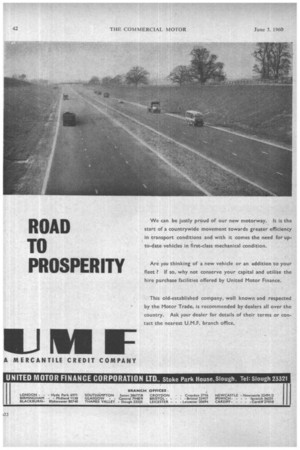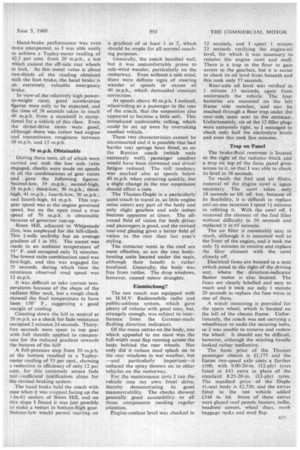ROAD TO PROSPERITY
Page 68

Page 69

If you've noticed an error in this article please click here to report it so we can fix it.
Hand-brake performance was even more unexpected, as I was able easily to achieve a Tapley-meter reading of 42.5 per cent. from 20 m.p.h., a test which caused the oTf-side rear wheels to lock. As this meter value is about two-thirds of the reading obtained with the foot brake, the hand brake is an extremely valuable emergency brake.
In view of the relatively high power• to-weight ratio, good acceleration figures were only to be expected, and the time of 38 seconds taken to reach 40 m.p.h. from a standstill is exceptional for a vehicle of this class. Even the direct-drive times were good, although-there wa-s rather bad engine and transmission roughness between 10 mp.h. and 15 m.p.h.
70 m.p.h. Obtainable
During these tests, all of which were carried out with the low axle ratio engaged, checks were made on speeds in all the combinations of gear ratios and gave the following figures: Second-low, 19 m.p.h.; second-high, 24 m.p.h.; third-low, 30 m.p.h.; thirdhigh, 41 m.p.h.; fourth-low, 50 m.p.h.; and fourth-high, 64 m.p.h. This topgear Speed was at the engine governed speed, but on the open road a true speed of 70 m.p.h. is obtainable because of governor run-up.
Bison Hill, adjacent to Whipsnade Zoo, was employed for the hill-climb. This +-mile acclivity has an average gradient of 1 in 101. The ascent was made in an ambient temperature of 55° F. and occupied only 31minutes. The lowest ratio combination used was first-high, and this was engaged for 35 seconds, during which time the minimum observed road speed was 12 m.p.h.
It was difficult to take current temperatures because of the shape of the radiator filler neck, but a rough check showed the final temperature to have been 150° F., suggesting a good margin of cooling.
Coasting down the hill in neutral at 20 m.p.h. as a check for fade resistance occupied 2 minutes 24 seconds. Thirty• five seconds were spent in top gear with full throttle applied to compensate for the reduced gradient towards the bottom of the hill! .
A full-pressure stop from 20 m.p.h. at the bottom resulted in a Tapleymeter reading of 53 per cent., showing a reduction in efficiency of only 12 per cent, for this extremely severe fade test—sufficient justification alone for the revised braking system. •
The hand brake held the coach with ease when it was stopped facing up the 1-in-61 section of Bison Hill, and on this slope I found it was just possible to make a restart in bottom-high gear. Bottom-low would permit starting on
a gradient of at least 1 in 5, which should be ample for all normal coaching purposes.
Generally, the coach handled well, but it was uncomfortably prone to side-wind wander, particularly on the motorway. Even without a side wind, there were definite signs of steering wander at speeds in excess of 40 m.p.h, which demanded constant correction.
At speeds above 40 m.p.h. I noticed, wherrriding as a passenger in the rear of the coach, that the suspension also appeared to become a little soft. This introduced undesirable rolling, which could be set up even by overtaking another vehicle.
These two characteristics cannot be unconnected and it is possible that had harder rear springs been fitted, as on the Russian coach (which rode extremely well), passenger• comfort would have been increased and driver fatigue reduced. The roll tendency was marked also at speeds below 40 m.p.h. when cornering quickly. but a slight change in the rear suspension should effect a cure. • The Thames-Duple is a -particularly quiet coach to travel in, as little engine noise enters any part of the body and only slight gearbox and axle noises become apparent at times. The allround field of vision for both driver and passcngers is good, and the revised rear-end glazing gives a better field of vision to the rear than last year's styling.
The extractor vents in the roof are most effective, as are the two bodyheating units located under the seats, although their benefit is rather localized. Generally, the body was free from rattles. The drop windows, however, caused minor draughts.
Einmischnng?
The test coach was equipped with an H.M.V. Radiomobile radio and public-address system, which gave plenty of volume with good tone, but, strangely enough, was subject to interference from the "German-made flashing direction indicators.
Of the many extras on the body, one which appealed to me most was the full-width mud flap running across the body behind the rear wheels. Not only did it reduce mud splash on to the rear windows in wet weather, but —and particularly important—it reduced the spray thrown on to other vehicles on the motorway.
For the maintenance tests I ran the vehicle into my own front drive, thereby demonstrating its good manceuvrability. The checks showed generally good accessibility to all those components needing regular attention.
,Engine-coolant level was checked in 12 seconds, and I spent 1 minute 23 seconds verifying the engine-oil level, for which it was necessary to remove the engine cowl and muff. There is a trap in the floor to gain access to the gearbox, but it is easier to check its oil level from beneath and this took only 57 seconds.
Rear-axle oil level was verified in 1 minute 13 seconds, again from underneath the vehicle. The four batteries are mounted on the left frame side member, and can be reached through a floor trap under the near-side seats next to the entrance. Unfortunately, six of the 12 filler plugs were extremely tight, so I managed to check only half the electrolyte levels and even this took five minutes.
Trap on Panel
The brake-fluid reservoir is rocated to the right of the radiator bloCk arid a trap on top of the facia panel gives access to it, so that I was able to check its level in 38 seconds.
To reach the fuel and air• filters, removal of the engine cowl is again necessary.. The "cowl takes only' 18 seconds to lift off, but, because of its flexibility, it is difficult to replace and on one occasion I spent 11 minutes in refitting it. With the cowl off, I removed the element of the fuel filter without difficulty in 50 seconds and replaced it in65 seconds.
The air filter is reasonably easy to reach, although it is mounted well to the front of the engine, and it took me only 31 minutes to remove and replace the filter element with the cowl already off.
Electrical fuses are housed in a neat switch panel to the right Of the driving seat, where the direction-indicator flasher motor is also located. The fuses are clearly labelled and easy to reach and it took me only 1 minute 20 seconds to replace the fuse wires in one of them.
A winch mounting is provided for the spare wheel, which is located on the left of the chassis frame. Unfortunately, the coach was not carrying a wheelbrace to undo the securing bolts, so I was unable to remove and restow the wheel. It should not be difficult, however, although the winding handle looked rather ineffective.
The basic price of the Thames passenger chassis is £1,175 and the Eaton two-speed axle costs a further £100, with 9.00-20-in. (12-ply) tyres listed at £43 extra in place of the standard 8.25-20-in. (12-ply) tyres. The standard price of the Duple 41-seat body is £2.730, and the extras fitted to the test vehicle added £348 4s. 6d. Some of these extras were glazed roof panels, heaters, radio, headrest covers, wheel discs, mesh baggage racks and mud flap.
















































































































